CALIFORNIA
Plants and Animals

Plants and Animals
Cities in CALIFORNIA
| Los angeles | San francisco |
Popular destinations USA
| Arizona | California | Florida |
| Hawaii | Utah |
Plants
Much of California is a biological island that is in fact cut off from the rest of North America by the Sierra Nevada. As in other similar instances in the world, evolution in these biologically isolated conditions created a variety of unique plants. California has the most endemic plants of all American states and 30% of all plant species in the United States are found in California.
California's 6,000 or so plant species can be very striking but also unobtrusive and similar, where only an experienced botanist can see differences. The state flower is the California poppy.
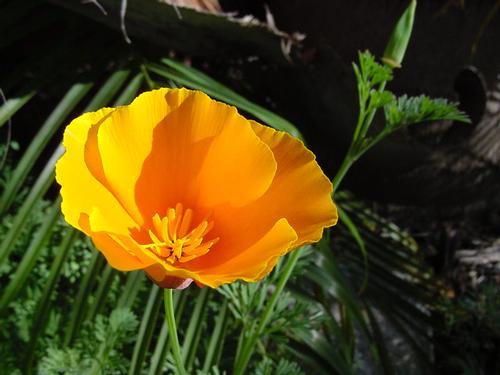 California poppyPhoto: Shizhao CC 2.0 Generic no changes made
California poppyPhoto: Shizhao CC 2.0 Generic no changes made
California is the region of super trees. The oldest tree in the world, a long-lived pine in the White Mountains, is nearly 5,000 years old. California also has the tallest trees in the world, the 'redwood', coastal redwood (Sequoia sempervirens), the tallest tree being the Hyperion at almost 118 meters. These trees are related to the giant sequoia and the water cypress, can live to be 2000 years old and over 100 meters high.
The Redwood National Park (23,500 acres) includes three state parks: Prairie Creek Redwoods State Park, Del Norte Coast Redwoods State Park, and Jedediah Smith Redwoods State Park; 3720 ha), where three quarters of the tallest trees in the world are located. Another state park is 20,200 acre Humboldt Redwoods State Park, which contains one of the largest coastal redwood forests in the Rockefeller Forest.
The largest and heaviest trees in the world are the giant sequoias (Sequoiadendron giganteum) on the western slopes of the Sierra Nevada, the only place in the world where these giants occur. The topper among the giant redwoods is the General Sherman Tree, almost 84 meters high, a diameter of about 11 meters, a circumference of more than 31 meters, a trunk volume of almost 1500 m³, a weight of perhaps 1200 tons and an estimated age from 2300-2700 years. The second largest giant redwood is the General Grant Tree in Kings Canyon's General Grant Grove; another giant is the Robert E. Lee Tree. These trees are all named after famous American Civil War generals.
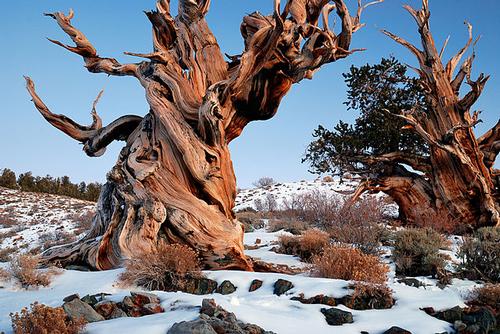 Long-lived pine in the White Mountains, CaliforniaPhoto: Rick Goldwaser CC 2.0 Generic no changes made
Long-lived pine in the White Mountains, CaliforniaPhoto: Rick Goldwaser CC 2.0 Generic no changes made
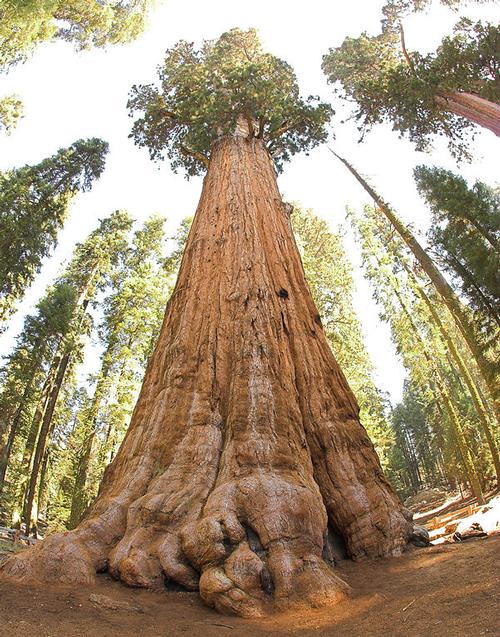 California giant redwood 'General Sherman Tree'Photo: Jim Bahn CC BY 2.0 no changes made
California giant redwood 'General Sherman Tree'Photo: Jim Bahn CC BY 2.0 no changes made
20 largest giant redwoods
| name | locaation | volume | height | outline | diameter | |
| 1 | General Sherman | Giant Forest Grove | 1487 m³ | 83,8 meter | 31,3 meter | 10,0 meter |
| 2 | General Grant | General Grant Grove | 1320 m³ | 81,7 meter | 32,8 meter | 10,4 meter |
| 3 | President | Giant Forest Grove | 1278 m³ | 73,4 meter | 28,3 meter | 9,0 meter |
| 4 | Lincoln | Giant Forest Grove | 1260 m³ | 78,0 meter | 30,0 meter | 9,5 meter |
| 5 | Stagg | Alder Creek Grove | 1205 m³ | 74,1 meter | 33,2 meter | 10,6 meter |
| 6 | Boole | Converse Basin Grove | 1203 m³ | 81,9 meter | 34,4 meter | 11,0 meter |
| 7 | Genesis | Mountain Home Grove | 1186 m³ | 77,1 meter | 26,0 meter | 8,3 meter |
| 8 | Franklin | Giant Forest Grove | 1169 m³ | 68,2 meter | 28,9 meter | 9,2 meter |
| 9 | King Arthur | Garfield Grove | 1151 m³ | 82,4 meter | 31,8 meter | 10,1 meter |
| 10 | Monroe | Giant Forest Grove | 1136 m³ | 75,5 meter | 27,8 meter | 8,9 meter |
| 11 | Robert E. Lee | General Grant Grove | 1136 m³ | 77,6 meter | 26,9 meter | 8,6 meter |
| 12 | John Adams | Giant Forest Grove | 1103 m³ | 76,4 meter | 25,4 meter | 8,1 meter |
| 13 | Ishi Grant | Kennedy Grove | 1080 m³ | 75,6 meter | 32,0 meter | 10,2 meter |
| 14 | Column | Giant Forest Grove | 1056 m³ | 74,3 meter | 28,3 meter | 9,0 meter |
| 15 | Summit Road | Mountain Home Grove | 1040 m³ | 74,4 meter | 25,1 meter | 8,0 meter |
| 16 | Euclid | Mountain Home Grove | 1023 m³ | 83,1 meter | 25,4 meter | 8,1 meter |
| 17 | Washington | Mariposa Grove | 1017 m³ | 71,9 meter | 29,2 meter | 9,3 meter |
| 18 | General Pershing | Giant Forest Grove | 1015 m³ | 75,0 meter | 27,8 meter | 8,8 meter |
| 19 | Diamond | Atwell Mill Grove | 1000 m³ | 87,2 meter | 29,0 meter | 9,2 meter |
| 20 | Adam | Mountain Home Grove | 992 m³ | 75,4 meter | 28,7 meter | 9,1 meter |
California also has twenty different oak species, including the largest of all, the Quercus lobata or valley oak (also called roble). Furthermore, the Quercus durata or leather oak, the Quercus douglasii or blue oak, the Californian black oak (also called black oak or Kellogg oak), the Quercus chrysolepis or canyon live oak (also called canyon oak, golden cup oak or maul oak), the Quercus wislizenii or interior live oak, the Quercus tomentella or island oak (also called Channel Island oak or island live oak), the Quercus engelmanni or Engelmann oak (also called Pasadena oak), the Quercus agrifolia or California live oak ( also called coast live oak) and the poisonous poison oak.
Other common trees include the aromatic California laurel, the Monterey pine, the Great Cone Pine, the Yellow Pine, the Twirled Pine, the Sugar or Giant (largest and most voluminous pine in the world), the American White Pine and the Foxtail Pine.
Torrey Pines State Reserves, on the coast and near San Diego, and Santa Rosa Island, are the only places in the world where the Torrey pine or Pinus torreyana (8-17 meters high) is found.
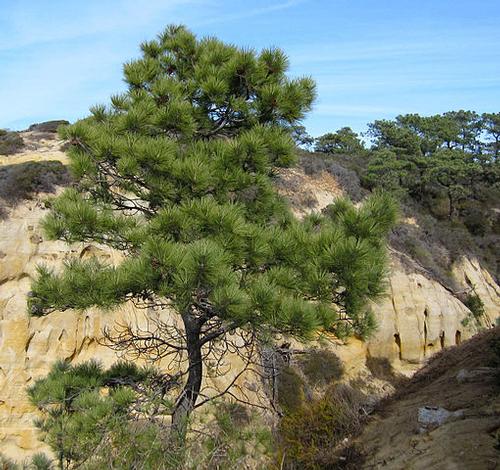 Pinus Torreyana, unique in CaliforniaPhoto: Richard O. Barry CC 2.0 Generic no changes made
Pinus Torreyana, unique in CaliforniaPhoto: Richard O. Barry CC 2.0 Generic no changes made
The Sierra Nevada has three eco zones: the dry western foothills with oak and 'chaparall', a type of Mediterranean maquis, with tough, woody shrubs with thick bark and small leaves; conifer forests from 600 meters; and the alpine zone above 2400 meters. The Sierra Nevada has several dozen conifer species, including the Douglas fir and the Pinus ponderosa or yellow pine. Well-known deciduous trees are the American aspen.
Of the many palm species found in California, the California fan palm is the only species native to California. The date palm was imported from Algeria in 1890.
In the Southern California desert areas, cacti and other plants have adapted to the harsh conditions, no less than about 900 different plant species have been counted. If there is enough rain in the winter period, the ground can be covered with a colorful flower carpet in the spring. Common but dangerously stinging are the 'jumping cholla' (Cylindropuntia fulgida), also known as the 'teddy-bear cactus' due to its woolly appearance, and the 'catclaw acacia' (Senegalia greggii).
Almost equally widespread are various types of fig (s) - or disc cacti with their flesh-like discs and the ocotillo, not a true cactus, which appears dead but only needs a little water to reach full bloom.
A special desert plant is the creosote bush, the oldest living creatures on earth, some specimens of which are about 5000 years old. Another remarkable desert plant is Yucca brevifolia or 'Joshua tree' (max. 15 meters high, making it the tallest yucca species or palm lily in the world), which mainly occurs in the Mojave Desert from a height of at least 600 meters and can be several hundred years old. 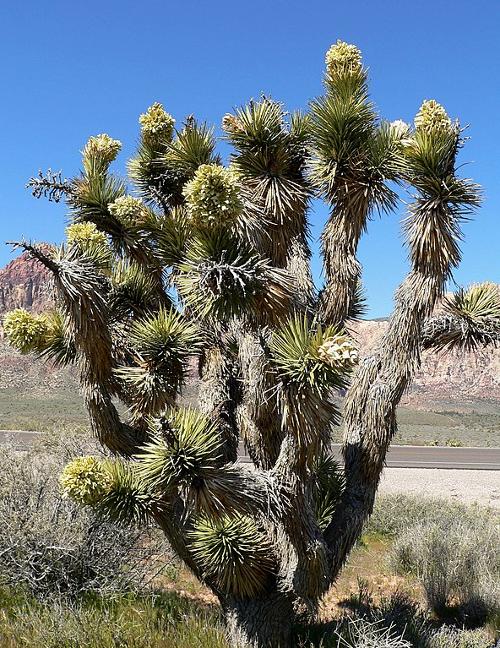 Yucca breviola is common in CaliforniaPhoto: Stan Shebs CC 3.0 Unported no changes made
Yucca breviola is common in CaliforniaPhoto: Stan Shebs CC 3.0 Unported no changes made
Animals
Much of California is a biological island that is in fact cut off from the rest of North America by the Sierra Nevada. As in other similar cases in the world, evolution created a variety of animals in these biologically isolated conditions. California therefore has the most endemic amphibians, reptiles, freshwater fish and mammals of all American states. Amazing Facts: 50% of all bird species and 50% of all mammals in the United States are found in California.
Bottlenose dolphins, porpoises, sea otters, California sea lions, gray whales, northern elephant seals and harbor seals are found along the California coast.
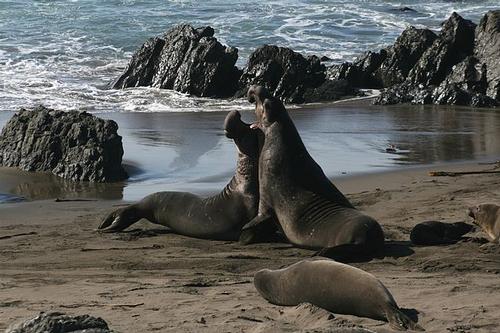 Northern elephant seals are found along the coast of CaliforniaPhoto: Brocken Inaglory CC 4.0 no changes made
Northern elephant seals are found along the coast of CaliforniaPhoto: Brocken Inaglory CC 4.0 no changes made
California's most symbolic mammal, the animal even featured on the state flag, is still the giant grizzly bear. Eradicated since the 1920s, grizzlies populated the beaches and grasslands of California, devouring everything in their way. However, they were especially common in the Central Valley, but fledged to the slopes of the Sierra Nevada as more hunted them.
The smaller black bear, which is also often much lighter in color, is still common in California, some 25,000-30,000 specimens live in the wooded slopes. this bear species is also omnivorous, and also occurs in the vicinity of human habitation.
Settlers have ensured that many more (large) mammals were oppressed in the 19th century, examples of which are the tulle-wapiti and the fork-goat. They used to be in large herds, now they can only be seen in a few places.
The mountain lion, also known as the mountain lion or silver lion, is found all over California, especially in areas with a lot of deer.
Many animals are also found in the deserts of California, but of course most animals do not show themselves during the day. Roadrunners often occur on the roadside. Other typical desert animals are the bat-eared fox, the tree-climbing gray fox, the black-tailed hare or black-tailed donkey hare, the desert kangaroo sacrifice from the family of the cheek pouch mice, the desert tortoise, the desert bighorn sheep and a wide variety of snakes (including the highly venomous horned rattlesnake), lizards (including the chuckwhalla) and spiders.
California is an essential resting point for about half of all migratory bird species that fly to Mexico from Alaska, especially during the wetter winter season. In October and November, for example, approximately two million ducks and geese congregate in the Klamath Basin in the far north of California. Mono Lake in the eastern Sierra Nevada is the breeding ground for about 85% of all prairie gulls in the world and brine shrimp swim in the very salty water.
The extinction of the California condor, a New World vulture species with a wingspan of more than three meters, has been halted for the time being. In 1987 only 27 specimens were still alive worldwide, all living in a protected (zoo) environment. Today there are more than 400 condors, and more and more captive-raised specimens are being released into the wild in hopes of becoming breeding pairs. In the wild, the condors can be seen on the coast at Big Sur and in the Pinnacles National Park.
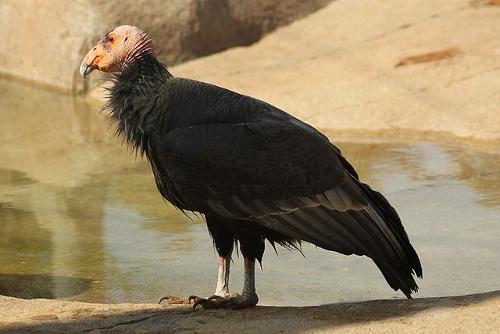 California condorPhoto: Stacy CC 2.0 Generic no changes made
California condorPhoto: Stacy CC 2.0 Generic no changes made
Endemic to the Mojave Desert is the bathing water snail, a snail species that feels very much at home in the salty habitat of Badwater, the lowest point in North America where temperatures of nearly 50°C are no exception.
The California porpoise or vaquita (also known locally as cochito) is one of the rarest mammals on Earth, with only about 30 specimens remaining in the northern part of the Gulf of California, according to a 2016 census.
California's fish-state symbol is the orange-colored Garibaldi or Garibaldi damselfish (Hypsypops rubicundus), a ray-finned fish from the reef bass or coral damselfish family.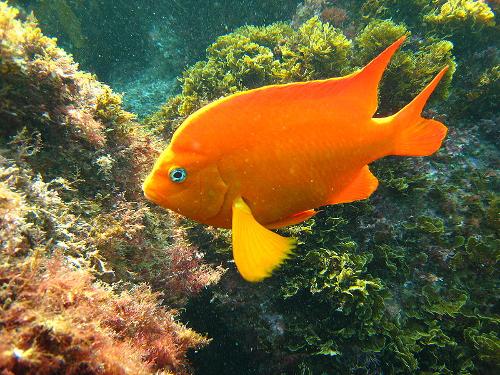 Garibaldi, California state fishPhoto: Star5112 / John CC 2.0 Generic no changes made
Garibaldi, California state fishPhoto: Star5112 / John CC 2.0 Generic no changes made
Two subspecies of the toothcarp species Cyprinodon nevadensis or Death Valley pupfish are found in two very isolated places in Death Valley National Park, the Cyprinodon salinus salinus is found in the Salt Creek and the Cyprinodon salinus milleri in the Cottonball Marsh. The fish can survive in water that is no less than four times saltier than the water of the ocean and water temperature differences of about 45°C are no problem for these fish species.
Pinnacles National Park (national park since 2012) is known for its enormous bee diversity: approx. 400 species can be found here.
Millions of orange-black monarch butterflies (also called American monarch) from the western United States and Canada gather to hibernate in Pacific Grove, Pismo Beach, Ventura and Montana de Oro State Park.
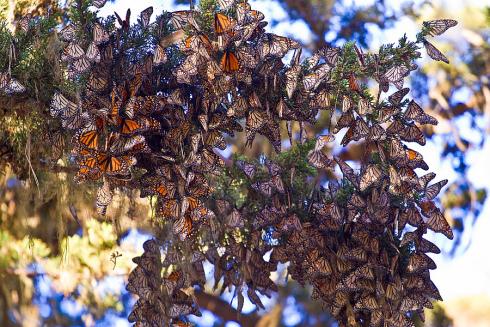 Monarch Butterflies in Pacific Grove, CaliforniaPhoto: Agunther CC 3.0 Unported no changes made
Monarch Butterflies in Pacific Grove, CaliforniaPhoto: Agunther CC 3.0 Unported no changes made
Catalina Island is home to plants and animals that are not found on mainland California. Some endemic plant species include the extremely poisonous wild tomato and rare mahogany and ironwood trees.
Several subspecies have developed on the island, including the Catalina California ground squirrel and the gray Catalina island fox. Bison has also been found on the island since 1924, for a film recording.
There are also many indigenous unique animal species on the Channel Islands, about 150 species. In addition to the island fox, the spotted island skunk and the island night lizard, the dwarf mammoth lived here in bygone times.
Island foxes are found in every habitat, except in areas that are severely affected by human activity or overgrazing. The island fox is only found in the six largest of the eight Channel Islands off the coast of Southern California, namely San Miguel, Santa Rosa, Santa Cruz, San Nicholas, Santa Catalina and San Clemente. The six different populations are sometimes considered separate subspecies.
- U.l. littoralis - San Miguel Island
- U.l. santarosae - Santa Rosa Island
- U.l. santacruzae - Santa Cruz Island
- U.l. dickeyi - San Nicolas Island
- U.l. clementae - San Clemente Island
- U.l. catalinae - Santa Catalina Island
A rare fringed lizard species, the Uma inornata, is found in the Coachella Valley.
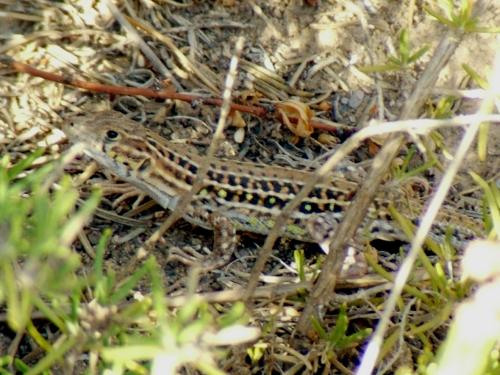 Uma inornata, fringe lizard in CaliforniaPhoto: Laura Collado y Javier Peraleda CC 2.5 Spain no changes made
Uma inornata, fringe lizard in CaliforniaPhoto: Laura Collado y Javier Peraleda CC 2.5 Spain no changes made
44 miles west of Point Bonita in the Bay Area are the Farallon Islands, important for nesting seabirds and a resting place for migratory birds, including California petrel, Brands cormorant, Cassin's auk, guillemot, pigeon guillemot, rhinoceros, crested puffin and California gull.
Anacapa Island is home to the largest colony of California sea lions in the world.
Sources
BBC - Country Profiles
Benson, Sara / California
Lonely Planet
Benson, Sara / Discover California
Lonely Planet
Californië
Uitgeverij Cambium B.V.
CIA - World Factbook
Elmar Landeninformatie
Hansen, Preben / 100% Californië & West-USA
Mo'Media
Heetvelt, Angela / Zuidwestelijke staten van Amerika
Gottmer/Becht
Mangin, Daniel / Californië : de reisgids voor een actieve & culturele vakantie
Wat & Hoe
Ominalowska, Malgorzata / Californië
Uitgeverij Unieboek/Het Spectrum
The Rough Guide to California
Rough Guides Ltd.
Schmidt-Brümmer, Horst / Lannoo's autoboek Californië en Zuidwest-USA : on the road
Lannoo
Vlahides, John A. / Northern California
Lonely Planet
Wikipedia
Zuidwest-USA
Uitgeverij Terra Lannoo
Copyright: Team The World of Info